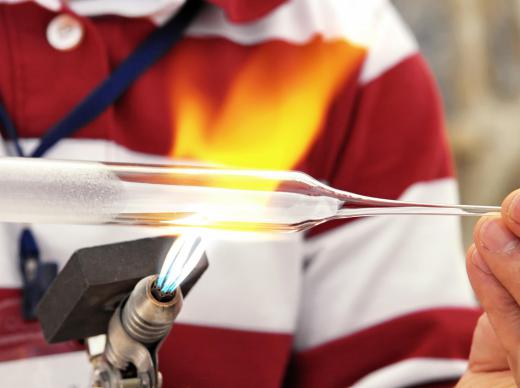Glass powder is an extremely fine powder made from ground glass. It can be used in a number of industrial and craft applications and is often available through suppliers of glass and industrial supplies. High precision machining equipment is necessary to prepare it, as it needs to be very uniform, with an even consistency. Costs vary, depending on the level of grind and the applications.
Some companies use recycled glass to make their glass powders, while others may use specially made glass. The process can involve dry or wet grinding to achieve particles of the desired size. Pigments can be added to make colored glass powders, and companies can also work with colored glass if they want to make powders of a particular color, like blue. The finished product can be hazardous and must be handled with care.

One use for glass powder is in crafts like glass fusing and cloisonné, where crafters carefully apply the powder, subject it to high heat, and allow it to melt. The crafter can control the precise shading of color as well as the distribution of color for very distinctive and visually interesting pieces. Jewelry, vases, and a variety of other objects can be made with glass powder. Molds are available for mass production of some types of finished pieces.

The early origins of glass powder in crafts can be hard to trace. Some African cultures were making power glass beads as early at 700 CE, while the famed glassmakers of Venice were readily applying the technology by the 1500s CE. Given the exchange of trade objects and ideas, it is possible that Venetian glassmakers picked up the skill from African trading partners, rather than inventing it independently.
Semiconductor manufacturers also use this product, as do some dentists, who can create very precisely matched fillings with the use of glass powder. These industrial powders are held to a higher standard of purity because their applications are more demanding. Companies need to handle and treat the glass with care throughout production to avoid introducing contaminants.
While handling glass powder, facial protection should be worn. The powder can irritate the eyes, nose, and mouth, so a full facial cover is important. It is also advisable to wear clothing that fits snugly and comfortably, and to cover garments with a smock or apron. If glass powder comes into contact with the skin, it can cause itching and discomfort.
Ever since she began contributing to the site several years ago, Mary has embraced the exciting challenge of being a About Mechanics researcher and writer. Mary has a liberal arts degree from Goddard College and spends her free time reading, cooking, and exploring the great outdoors.

